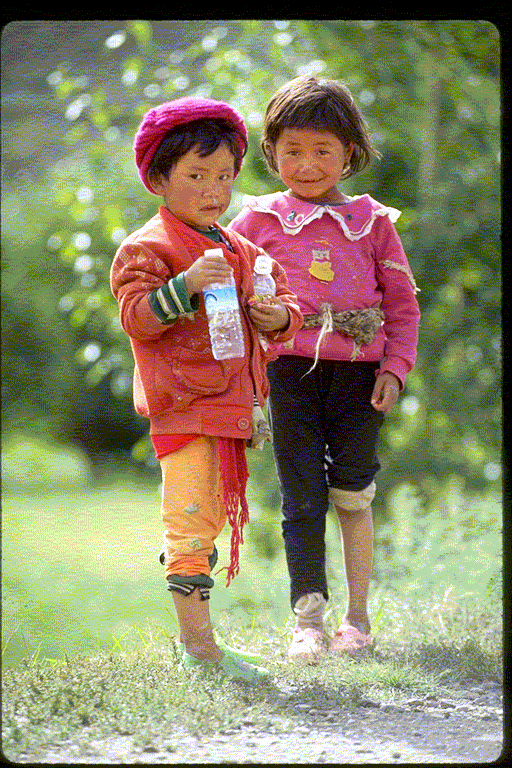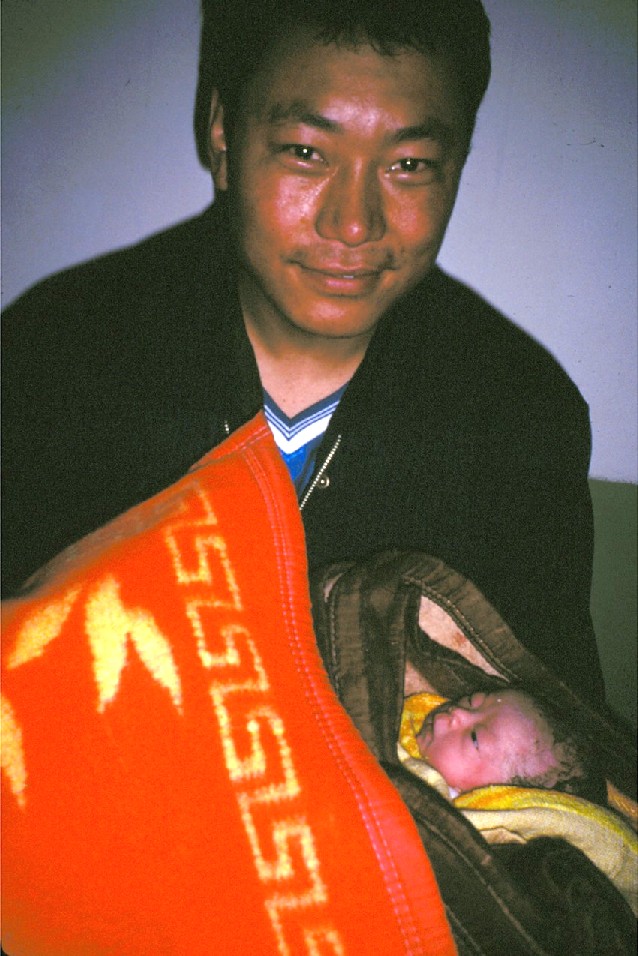
VOL.10 NO. 4 SPRING 2001
 GETTING
TO THE HEART OF THE MATTER
GETTING
TO THE HEART OF THE MATTER
Global-minded
health-care practitioners at the U lend their skills—and hearts—to Tibetans
by Linda Marion
Photos by John Speed
Tibet. The name conjures up images of towering, snow-covered peaks, hidden valleys, and lost horizons. It brings to mind Buddhist monasteries and red-robed monks, ruddy-cheeked herdsmen in brightly colored clothing, and herds of yak crossing the high, wind-swept plains—a National Geographic photographer’s paradise.
For centuries Tibet was a cloistered country, shrouded in mystery. Surrounded by India, Nepal, Bhutan, Burma, and China, it occupies the heart of Asia. Roughly the size of Utah and Nevada combined, Tibet (known as the Tibetan Autonomous Region since 1965) harbors a population of roughly six to seven million people, most of whom live in small villages spread throughout the country. About 170,000 inhabit the capital of Lhasa, once known as the Forbidden City because of its hostility to outsiders.
Tibet was brought abruptly out of obscurity with the Chinese takeover of the country in 1951 in the wake of the Communist revolution. Shortly thereafter, when its spiritual leader, the Dalai Lama, fled across the border and took up official residence in Dharmsala, India, global attention focused on the plight of a government in exile. Since then, the doors to the country have slowly opened, allowing a glimpse of the goings-on inside.
In the summer of 1999, a team of health practitioners from the University of Utah crossed the threshold. They were given permission by the Chinese government to enter Tibet for humanitarian reasons—to provide obstetrical and gynecological care to Tibetan women. In the end, the team came away with a revolutionary idea of its own.
Members of the medical team included group leader Dr. Michael W. Varner, a professor in the Division of Maternal-Fetal Medicine; Dr. Michael A. Belfort, maternal-fetal medicine; Dr. Bruce Bray, cardiology; Dr. Kathleen Digre, neurology; Dr. David Gontrum, family practice; Dr. Devon Hale, infectious disease; Dr. Helene Hewitt, neurology; Dr. Carol Osborne, family and preventive medicine; nurse practitioner Arlene Samen, obstetrics and gynecology; Dr. John Speed, physical rehabilitation; and nurse practitioner Sam Whitney, curriculum development and midwifery. The U of U team was joined by Dr. Roger Brecheen, a specialist in obstetrics and gynecology, and nurse practitioner and midwifery instructor Theresa Lerch, from Jackson Hole, Wyoming.
 Samen
describes the group’s experience that summer and the evolution of events
that followed. “We had heard rumors from rural women about children dying
from various illnesses,” she explains. “Stories abounded about children’s
physical problems and ailments.” In questioning some of the women about
difficulties experienced in birthing, the medical team traced many of
the problems to the lack of prenatal and natal care.
Samen
describes the group’s experience that summer and the evolution of events
that followed. “We had heard rumors from rural women about children dying
from various illnesses,” she explains. “Stories abounded about children’s
physical problems and ailments.” In questioning some of the women about
difficulties experienced in birthing, the medical team traced many of
the problems to the lack of prenatal and natal care.
Saman points out that Tibetan women in rural areas don’t traditionally receive prenatal care or have their babies in hospitals. The distances are too great and the hospitals too few. Consequently, she explains, “they deliver at home, often by themselves. If there is a woman in the village who attends the birth, she only cuts the [umbilical] cord. They know nothing about sterile birth techniques, like washing their hands, giving fundal massage, or shifting the baby if it’s in the wrong position.” In short, she sighs, “the women either survive or they don’t.”
The statistics reinforce the seriousness of the problem: one in 30 Tibetan women dies during pregnancy and childbirth—as opposed to one in 10,000 in the U.S.—and 46 percent of infant mortality is related to the lack of basic prenatal and natal care.
During that summer, the U of U team of volunteers treated other health issues affecting the Tibetan population as well. “Once the presence of Western doctors became known,” Samen continues, “a number of people came to our hotel for treatment.” In the process, the medical team became acutely aware of other widespread health problems, such as diarrhea, pneumonia, TB, hepatitis, anemia, hypertension, and stroke, that were too persistent to ignore.
Their concern ultimately led to the establishment of the One H.E.A.R.T. Project (Health, Education And Research in Tibet). The brainchild of Samen, the project aims to improve Tibetan health by establishing a network of practitioners to relay safe educational and research practices to Tibetan health-care providers. Its objectives are ambitious, but not unrealistic, and include:
- developing an educational training program for physicians and health-care workers in order to reduce deaths and disease;
- establishing a low-fee, walk-in model clinic in the capital of Lhasa that can be replicated in other areas of Tibet;
- training local health-care providers to run the clinic year-round and staff it with local physicians;
- developing urban and rural workshops on safe midwifery practices;
- designing and setting up a health-care database to identify and track the incidence and prevalence of disease and deaths in the various regions.
In the summer of 2000, U of U medical personnel returned to Tibet to lay the groundwork for the project. The group’s commitment intensified during the return visit. As Varner says, “The amount of good that can be achieved in Tibet by teaching people things that we take for granted, like sterile technique and the basics of clinical diagnosis and treatment, is staggering. It really makes you feel like you’re doing something to improve people’s quality of life.”
As a critical care specialist in obstetrics, Samen is particularly interested in improving the prenatal and natal care of Tibetan women, and in teaching them safe delivery practices in order to prevent birth defects and other birth-related illnesses and conditions.
Samen received her ob-gyn training in the trenches of the war on poverty in rural America—working first on a Navajo Indian reservation, then in the hills and hollows of Appalachia (southern Pennsylvania and West Virginia). There, she observes, “the poverty is unbelievable. It was a wrenching experience to find such conditions in our own backyard.”
 It
was, however, good preparation for taking on the challenges of Tibet.
While the project sometimes seems overwhelming, Samen confirms that “the
team’s commitment is definitely there,” citing a poignant example. “On
our first day [in summer 1999] we saved the lives of a mother and her
child. The mother would have bled to death and the baby would have died
if we hadn’t intervened.” The following summer word spread through the
rural network that the Western health workers were back in town, and their
former patients—mother and child, along with the baby’s father—sought
them out to greet and thank them. “They had given the baby my Tibetan
name, ‘Angel,’” Samen says, eyes tearing up. “I was so touched I had to
go into the other room, where I just sat and sobbed. And I thought, ‘No
matter how hard it is, we just have to continue.’”
It
was, however, good preparation for taking on the challenges of Tibet.
While the project sometimes seems overwhelming, Samen confirms that “the
team’s commitment is definitely there,” citing a poignant example. “On
our first day [in summer 1999] we saved the lives of a mother and her
child. The mother would have bled to death and the baby would have died
if we hadn’t intervened.” The following summer word spread through the
rural network that the Western health workers were back in town, and their
former patients—mother and child, along with the baby’s father—sought
them out to greet and thank them. “They had given the baby my Tibetan
name, ‘Angel,’” Samen says, eyes tearing up. “I was so touched I had to
go into the other room, where I just sat and sobbed. And I thought, ‘No
matter how hard it is, we just have to continue.’”
 One
of the issues to confront is the influence—positive and negative—of Tibetan
superstitions. Because the birthing process is considered unsanitary,
women deliver their babies outside the house, even in the freezing cold
of winter. “If they’re lucky,” says Samen, “they’ll have a barn to go
to where they can deliver.”
One
of the issues to confront is the influence—positive and negative—of Tibetan
superstitions. Because the birthing process is considered unsanitary,
women deliver their babies outside the house, even in the freezing cold
of winter. “If they’re lucky,” says Samen, “they’ll have a barn to go
to where they can deliver.”
While it may seem primitive by Western standards, traditional Tibetan medicine, which is 2,000 years old, has led to the development of some unique treatments that rely on herbal medicines. For breech births “they use a combination of herbs, along with different acupressure points, that work to turn the fetus around if it’s in the wrong position,” explains Samen. “A study in The Journal of the American Medical Association (JAMA) shows that there is a higher rate of success with the herbal method than with the modern version.”
This underscores One H.E.A.R.T’s commitment to work within the confines of Tibetan cultural boundaries and not to impose Western values. The project administrators recently applied for a grant that, if approved, will allow them to collaborate with the Tibetan medical college and several hospitals in designing a maternal and new-born care program that incorporates Tibetan cultural beliefs. They will work side by side with Tibetan doctors in order to learn more about their medical practices, and hope to produce a training manual in the Tibetan language, which most Tibetans speak (rather than Chinese) but don’t always read.
The problem of illiteracy affects both medical personnel and patients. Last summer, when Samen and other U of U practitioners were training a group of rural women in perinatal health-care practices, they found that about half of the women were illiterate. “But it didn’t matter,” says Samen. “We taught them with picture cards and sign language. They were so motivated. They don’t want other women to suffer or die, and they do want their children to live.” The manual will still be distributed to those who can’t read in the hope that someone in the local village can interpret it.
One of the most important issues for the project is funding. The survival of One H.E.A.R.T. will depend on the kindness of strangers, as the project is supported entirely by donations. “Up to now,” Samen says, “we have been able to raise enough funds to get us there and back, and pay for our accommodations. We’ve received some tremendous support, but it’s an uphill battle.”
Even though the scope of the project is daunting, Samen and her colleagues— all volunteers, as time away from their work allows—are convinced that it will ultimately succeed. But the optimism is tempered by a dash of realism. “It’s like the story [paraphrased from Loren Eiseley’s The Star Thrower] of the little boy who was picking up starfish that had washed up on the beach,” she says, “and throwing them back into the ocean. Even though there were thousands and thousands of starfish, the boy seemed undaunted. A man approached and asked the boy what he thought he was doing. ‘I’m saving the starfish,’ the boy responded, ‘one at a time.’”
—Linda Marion BFA’67 MFA’71 is managing editor of Continuum.
Continuum
Home Page - University of Utah Home
Page - Alumni Association
Home Page
Table of Contents
Copyright 2001 by The University of Utah Alumni Association